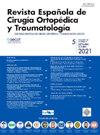[Translated article] Complications of intraosseous administration of vancomycin in total hip arthroplasty
Q3 Medicine
Revista Espanola de Cirugia Ortopedica y Traumatologia
Pub Date : 2025-07-01
DOI:10.1016/j.recot.2025.04.004
引用次数: 0
Abstract
Introduction
The incidence of periprosthetic joint infection (PJI) in hip surgeries has significantly decreased thanks to intravenous (IV) antibiotic prophylaxis. However, in patients colonised with methicillin-resistant Staphylococcus aureus (MRSA) or those at risk of colonisation, it is necessary to include vancomycin in the prophylaxis. Intraosseous administration of vancomycin could enhance its effectiveness in total hip arthroplasty (THA).
Materials and methods
A retrospective study was conducted between March and December 2023 involving 53 patients scheduled for primary THA with colonisation risk factors. The median age of the patients was 67 years (range 61–75), and all received treatment with intraosseous vancomycin (500 mg). Detailed records and documentation of complications during hospitalisation and the first three months post-surgery were maintained. As a secondary outcome measure, the incidence of PJI was explored.
Results
We administered 500 mg of intraosseous vancomycin, injected into the greater trochanter, along with standard IV prophylaxis. The incidence of complications was 1.64%. The PJI rate at 90 days was 0%.
Conclusions
Intraosseous administration of low-dose vancomycin in THA for patients at risk of MRSA colonisation, combined with standard IV prophylaxis, was shown to be safe and did not present significant adverse effects. Furthermore, this strategy eliminates the logistical challenges associated with timely vancomycin administration.
Level of evidence IV: Case series.
全髋关节置换术中骨内给药万古霉素的并发症
由于静脉注射(IV)抗生素预防,髋关节手术中假体周围关节感染(PJI)的发生率显著降低。然而,对于有耐甲氧西林金黄色葡萄球菌(MRSA)定植的患者或有定植风险的患者,有必要在预防中使用万古霉素。在全髋关节置换术(THA)中,骨内给药万古霉素可提高其疗效。材料和方法在2023年3月至12月期间进行了一项回顾性研究,涉及53例具有定植危险因素的原发性THA患者。患者的中位年龄为67岁(61-75岁),所有患者均接受骨内万古霉素(500mg)治疗。保留住院期间和术后头三个月并发症的详细记录和文件。作为次要结局指标,我们探讨了PJI的发生率。结果我们给予500 mg万古霉素骨内注射到大转子,同时给予标准静脉注射预防。并发症发生率为1.64%。90天PJI利率为0%。结论在有MRSA定植风险的THA患者中,经骨给药低剂量万古霉素,并结合标准静脉预防,是安全的,没有出现明显的不良反应。此外,该策略消除了与及时给药万古霉素相关的后勤挑战。证据等级IV:案例系列。
本文章由计算机程序翻译,如有差异,请以英文原文为准。
求助全文
约1分钟内获得全文
求助全文
来源期刊

Revista Espanola de Cirugia Ortopedica y Traumatologia
Medicine-Surgery
CiteScore
1.10
自引率
0.00%
发文量
156
审稿时长
51 weeks
期刊介绍:
Es una magnífica revista para acceder a los mejores artículos de investigación en la especialidad y los casos clínicos de mayor interés. Además, es la Publicación Oficial de la Sociedad, y está incluida en prestigiosos índices de referencia en medicina.
 求助内容:
求助内容: 应助结果提醒方式:
应助结果提醒方式:


